The Cornell Lab Bird Academy › Discussion Groups › Joy of Birdwatching › Activities: Exploring Bird Habitats
-
1. Near my parents home in Putnam County, NY, which is a development about 10 years old in which the builder leveled all the trees before building and just now are the new trees and more natural areas coming back. One of the neighbors has a few bluebird boxes hung up and the bluebirds and tree swallows take advantage of them every year. In the same development another neighbor has a few feeders hung up that attract 10-20 American Goldfinches as well as other birds at one time. It is a sparse area, not much other wildlife, some deer, a rare squirrel but the birds seem to have made their way back and found comfortable spots to feed and nest. Turkey vultures and a few hawks routinely fly over head. Canada Geese, Robins, finches, sparrow, swallows and bluebirds are common.



-
 Tanagers were in the manmade pond/waterfall in my wooded yard. I also see many woodpeckers, cardinals, nuthatches, and starlings regularly. At the lake about a quarter of a mile down, there are blue herons, swans, mallards, geese and kingfishers. Occasionally eagles are present as well.
Tanagers were in the manmade pond/waterfall in my wooded yard. I also see many woodpeckers, cardinals, nuthatches, and starlings regularly. At the lake about a quarter of a mile down, there are blue herons, swans, mallards, geese and kingfishers. Occasionally eagles are present as well. -

-
Activity 1: Now that some of our local trails have opened, I had a chance to visit a nearby canyon trail. It has upland scrub, some limited riparian, and a pond at the beginning. I heard a lot more birds that I saw, but there were hummingbirds, and a California Thrasher in the scrub area, I heard some drumming in the trees in the riparian section, but was unable to locate the bird. Today there were no water birds at the pond, I have seen ducks and a great blue heron in the past. Activity 2: I looked at the species ebird lists for the 2 Arizona sites. The Roger Road site appears to have both shrubby/scrubby habitat types and some wetlands features, while the Mt. Lemmon site appeared to have more birds that like forested habitats.
-
Exploring 2 English e-bird hotspots At Down House (a home of Charles Darwin ) was described by Darwin as "being situated on rather high table-land, has somewhat of desolate air ... The charm of the place to me is that almost every field is intersected (as alas is our's) by one or more foot-paths— I never saw so many walks in any other country", I used e-bird to screen just 2020 sightings and there were only 27 species seen by only 2 birders. There were only birds of the fields and scattered forests. No water birds of any kind. The land has had a house for hundreds of years and there are enough old trees for a woodpecker population. Several raptors were also observed and introduced species (ring necked pheasant) by the English gentry. Sevenoaks is a wildlife preserve which includes ponds (looks to be freshwater from map). 75 species were observed in the same 2020 period. There were many water-birds including herons and ducks and geese. There were most of the birds from the Down House as well. Similar to many of the observations from classmates in the course so far, the presence of water nearby enriches the variety of birds and their visibility.
-
Hi, all. I live in the southeast corner of British Columbia, Canada. I walk daily near 2 ponds and a larger lake in a park. I've seen ducks, hawks and bald eagles at the ponds and the lake. However, the lake is the only place I've seen loons, flycatchers and sandpipers. The ponds are the only place I've seen Red-winged Blackbirds. (This difference in sitings could be my own limited ability to see birds that are there.) I live across the road from a vacant grass field. I hear different bird songs than I do on my walk through the park. I think I can identify the song of the Western Meadowlark which is the only bird I've identified in the field.
-
I looked at the bird sitings of Down House and Sevenoaks. I think Sevenoaks must be an aquatic habitat with a tidal pond and marsh/ wetlands as the birds sitings include swimming birds, shore birds and sea birds. There bird sitings also included doves etc that are habitat sharers. Down House may be predominantly scrub-shrub (maybe a field) with a forested area. The sitings that made me think shrub-scrub were pheasants, swallows, and larks. I thought there was a forest because of the nuthatches, finches, jays and crows.
-
Exploring Bird Habitats Activty 1 visit 2 different habitats and look for differences In Estero FL (longer than usual due to COVID 19) and having hip issues so I went to my lanai (second story in a strip of big Live Oak trees and Palms) and a spot on a nearby pond where I go all the time. The rainy season has started and there is a rainy season puddle off my lanai making the sightings much more similar than they are in mid winter dry season. From lanai I only saw a blue jay in the tree but was slow with the camera and you all see them regularly. Then a big bird flew in and landed in the puddle. It was a little blue heron. He stood still for a while and then dashed over to the edge of the puddle and speared a tree frog. He/she then went back to edge near the bushes and waited again. A second one came but left quickly. Based on the noises from the trees, most frogs have emerged from the pool and it is not yet full of this years crop of pollywogs and maturing frogs.
 When I went over to the pond I saw redwing blackbirds and two interesting waterside sites.
When I went over to the pond I saw redwing blackbirds and two interesting waterside sites. One was a reddish egret (new bird for me this week) seen above with an Ibis. Below was where 2 of the ibis that are usually there went. Lok in the tree to their right and there was also a great blue heron in a place one might expect a raptor. He was about 40 feet above the mangrove and most smaller pines. I had seen the ibis but missed the great blue with out the aid of my 300mm of telephoto.
One was a reddish egret (new bird for me this week) seen above with an Ibis. Below was where 2 of the ibis that are usually there went. Lok in the tree to their right and there was also a great blue heron in a place one might expect a raptor. He was about 40 feet above the mangrove and most smaller pines. I had seen the ibis but missed the great blue with out the aid of my 300mm of telephoto.
 I went to familiar places and saw unfamiliar sights. Fun with birding..
I went to familiar places and saw unfamiliar sights. Fun with birding.. -
I visited an area with open grassy fields alongside wetlands surrounded by a little bit of young forest. We were able to see Great Egrets, a Green Heron, and many Canada Geese in the wetlands, swallows and warblers in the grassy areas and trees, as well tons of Red-winged Blackbirds everywhere. In contrast, I live in an urban area, and the birds I observe are unlikely to be egrets and herons, but the Red-winged Blackbirds seem to really like it here too!
-
Activity 1: We visited two of our favorite birding spots over the weekend. The first one is Duranceau Park & Griggs Reservoir and the second is Walnut Woods Metro Park. Both are in Columbus, Ohio. The first area is the best area we've found to spot warblers, Baltimore Orioles, and river birds such as the Great Blue Heron. The second area has two different sections - one section is meadow and open fields with ponds and the second section has tall trees, both deciduous and pine. We have found Field Sparrows, Red-wing Blackbirds, Tree Swallows and numerous woodpeckers here. By the way, I observed a Great Blue Heron do the same side leg and wing stretch. I never noticed any bird do this before until this course. We also are loving the Merlin app! My husband finally broke down and bought a good pair of binoculars on Amazon so he is much more interested now in birding with me than before. I am noticing birds so much more now than I ever did before. Activity 2: Both the Roger Road location in Arizona and the Sevenoaks location near London feature pond birds whereas the Mt. Lemmon and Down House locations have forest birds (and especially at Mt. Lemmon raptors). These last two locations have a greater diversity of birds, not just waterfowl. Below are three photos of birds from our weekend birding, including a Canada Warbler, Indigo Bunting, and Red-eyed Vireo.



-
 We visited two local wooded trails (well known to us but now seen in a new light) with descriptions from our area Audubon birding map. The first site has a pond that attracts mallards, Wood Ducks, and (rarely) Green Herons. We didn't spot any ducks here although we had recently seen them at a National Wildlife Refuge Center (photo of mallard enclosed). One bonus of this hilly trail walk was noting we'd have a great high perch along this trail for viewing hawk migration in the fall. The second site visited was a trail alongside a creek that hosts large conifers and a shrubby understory used as habitat for migrant and wintering birds. We keep our Birding map in the car now---along with our binoculars!
We visited two local wooded trails (well known to us but now seen in a new light) with descriptions from our area Audubon birding map. The first site has a pond that attracts mallards, Wood Ducks, and (rarely) Green Herons. We didn't spot any ducks here although we had recently seen them at a National Wildlife Refuge Center (photo of mallard enclosed). One bonus of this hilly trail walk was noting we'd have a great high perch along this trail for viewing hawk migration in the fall. The second site visited was a trail alongside a creek that hosts large conifers and a shrubby understory used as habitat for migrant and wintering birds. We keep our Birding map in the car now---along with our binoculars! -
Activity 1: I live in Maryland, and we have a very diverse habitat. In a commons by my house, there are 3 different habitats in small areas. It is a great birding area because of this diversity. First, there is a beautiful field bordering a forest, where we find robins, bluebirds, and sparrows. Then, as you get into the woods, we see warblers, thrushes, and woodpeckers. I recently spotted a black-throated green warbler on the edge of a field, which was a lifer for me. You then come out to a sizable creek, where warblers, sparrows, and shorebirds reside. There, I spotted an Osprey, which we have seen flying around our neighborhood. It’s amazing the birding hotspots you can find just mere blocks away from your home.

-
1. Wooded valleys with old growth eucalypts. Nesting hollows for Powerful Owls and Cockatoos. Smaller hollows for other parrots. Lower bushes and undergrowth provide cover for smaller birds such as honey eater species and Silver Eyes. River banks often occupied by ducks, gulls, herons etc. Grassy areas and open woodland have Magpies and parrots.
-
Activity 1. The area I live in is a peninsula between the George’s and Wa
-
Activity 1: I visited the Harris Neck National Wildlife Refuge this past Sunday. It's a big nesting spot for Wood Storks, and there were literally hundreds if not thousands of those guys. At Harris Neck, you can find a lot of species of coastal birds and waterfowl. One I was unfamiliar with was the Black-bellied Whistling Duck (pictured), and I used Merlin to identify them. While I didn't see one that day, Harris Neck is also home to the Painted Bunting - one of my favorite birds! Since the refuge consists of saltwater marsh, grassland, mixed deciduous woods, and cropland, this is a great spot to view a great variety of bird species. As I'm typing this, I'm at another location: my town's local high school (about 30 minutes from the refuge). I'm the librarian there, and I am currently sitting outside waiting for students to drop off their library books for the end of the year. Anyway, I'm facing an open athletic field and a few medium-sized trees and bushes. Besides the bunny that is hopping from bush cluster to bush cluster, there are about ten or so Boat-Tailed Grackles (thanks again to Merlin!) who appear to spend most of their day around this spot. While you would probably find these at Harris Neck also, they are unavoidably noticeable here. They are loud and extremely visible. Not shy at all. There is a also a mockingbird that drops by occasionally. At any rate, this place is definitely NOT conducive to species like Wood Storks or Painted Buntings.

-
I visited a certain suburban neighborhood that was recently constructed, and it is very hard to find birds in it. There aren't any mature trees or open natural grassy areas in the neighborhood for foraging. It's just planted sod with hardly any weeds, and the inhabitants use lawn chemicals all the time. It's very sad. However you can find some birds if you know where to look. In the one tree that is medium-sized, lots of House Sparrows chirp. They may be seen hopping on the sidewalk too. House Finches live nearby in the gutter of one of the cookie-cutter homes. If you look up in the sky for a while, you can spot soaring Turkey Vultures looking for road kill. All these birds are generalists, and they are able to make a home in the uninviting neighborhood. A little walk to the edge of the neighborhood reveals a small area of habitat that is easy to look past. Perhaps it is the only "eyesore" in the entire place, although a necessary one. It is the drainage ditch, and the water-loving plants that grow in the center are unable to be mowed down. On the electrical poles and from the cattails is the song of the Red-Winged Blackbird, which prefers a wetland habitat. The ditch is only big enough for one family group, but at least it's something.
-
Sigh... yes, a depressingly common "habitat" these days... the neighborhood was probably called something like, "Hidden Grove." Pretty hidden alright... Otherwise, great post -- and thanks for continuing to explore even in suburban wasteland!
-
-
Activity 1: The first place I went was my front yard, which is in a suburban area. There are a few big trees, and lots of wide open grassy yard. It is also near a busy road, and surrounded by houses and telephone poles. I House Sparrows and House Finches in the trees. I saw starlings poking around in the grass in my yard. I saw doves on the telephone poles. Next, I went to a nearby pond. Here, there is a large-ish body of water with a bridge over it. There's a rock barrier separating a secluded spot from the rest of the pond. There are a few smaller willows. Here, I see many Mallards and coots. I also see Barn Swallows catching bugs over the water and perching under the bridge. I see gulls and cormorants perching on the barrier.
-
I wonder if coastal dune scrub would fit under shrub habitats. I find bluebirds, nuthatches, shrike, phoebes, kestrel, yellow-rumped warblers, gnatcatchers, tree swallows, mockingbirds, thrashers, towhees, dove, and a few sparrows if I'm lucky.
-
activity 2: Roger Road. Wetlands, mountains on both sides, parks, river, a large number of species, feeders of many varieties. Likely a large migration area due to the abundance of food. The many duck varieties would have leaves, reeds, small fish and crustaceans. Many tree feeders like the sparrows. Flowers for the hummingbirds. Park and open areas for hawks to hunt. Some flycatchers. Mt. Lemmon: Half the number of species as Roger Road. A great deal more larger birds; hawks hunting, woodpeckers who have a varied appetite for insects, nuts, sap and pine seeds. Being a mountain area there are likely a lot of evergreens; a perfect place for hawks and Ravens to sit and watch for rodents. A number of tree foragers like the sparrows. Colder temperatures and limited food sources, compared to Roger Road. Most of the species there likely are permanent/seasonal residents.


-
Activity 1: Surprising to me, by our large lake, there is not a lot of diversity. A lot of Canada Geese, some Mallards and other migrating ducks, Sandpipers, and a few birds in the large trees close by (American Goldfinch, European Starlings, ). In the marshes close by are Great Blue and Grey Herons, Mallards, Ruddy Ducks, Gadwall, American Coots, hybrid ducks, American Wigeon, sparrows, Osprey, and on and on. The marshes have so many food sources compared to the lake. I have seen the herons at the lakeshore, but not often.


-
Activity 1: Two different habitats that I frequent when out birding are 1) a wooded and reedy riverbank, and 2) a wetland forest area. I definitely see different species in each, though there is an overlap. In the former, I see many water fowl (e.g., Mallards, Great Blue Herons, Double-Crested Cormorants, Greater Scaups, etc), as well as a large quantity of Red-Winged Blackbirds, Tree Swallows, and Song Sparrows. In the latter, I also see Red-Winged Blackbirds, but I rarely see any water fowl or Song Sparrows. Instead, I see American Robins, Common Grackles, sometimes White-Breasted Nuthatch, a few different species of woodpeckers, and a wider variety of warblers. Activity 2: I compared species at the two locations in Arizona. Roger Road seems to be a wetland. We see water fowl, a variety of sparrows, birds that forage in shallow water, like Great Egrets, and so on. By contrast, Mt. Lemmon seems to be, well, a mountain top. We see a larger variety of hawks, woodpeckers, and other birds that live in forests. I would guess it is a forested mountain trail.
-
I thought Roger Road in Arizona was more aquatic in nature (like a lake or pond) since I found swimming birds. Mount Lemmon in Arizona was more like a scrub shrub because there were chicken like birds, hummingbirds, fliers, raptors and owls. In London at the Down House it seemed to be more urban with Pigeon and Dove, songbirds and fliers. Seven Oaks London had an aquatic nature (maybe a lake) with swimming birds; ducks, seabirds; gulls, pigeons and doves and fliers. This was hard a hard exercise!
-
Activity 1: This optional activity was a bit more challenging given widespread park closures, uncooperative weather, etc., but I found it very rewarding: different habitat, different birds! I guess I’d never really paid careful attention to it — and especially not while traversing among habitats.
 Open habitats: I drove to a parking area along a road adjacent to cow pastures. Along the fence line, I spotted a number of Tree Swallows (https://www.allaboutbirds.org/guide/Tree_Swallow/) going in and out of nest boxes there and also zipping and darting through the air above the field. Leaving the parking area on foot, I saw a Barn Swallow (https://www.allaboutbirds.org/guide/Barn_Swallow/), who, I kid you not, flew out of a barn! It was possible to further distinguish him by his deeply forked tail and orange-brown underside. Soaring above the fields were a few Turkey Vultures (https://www.allaboutbirds.org/guide/Turkey_Vulture/), judging by the gray flight feathers. They were riding thermals and looking for, presumably, dead stuff.
Open habitats: I drove to a parking area along a road adjacent to cow pastures. Along the fence line, I spotted a number of Tree Swallows (https://www.allaboutbirds.org/guide/Tree_Swallow/) going in and out of nest boxes there and also zipping and darting through the air above the field. Leaving the parking area on foot, I saw a Barn Swallow (https://www.allaboutbirds.org/guide/Barn_Swallow/), who, I kid you not, flew out of a barn! It was possible to further distinguish him by his deeply forked tail and orange-brown underside. Soaring above the fields were a few Turkey Vultures (https://www.allaboutbirds.org/guide/Turkey_Vulture/), judging by the gray flight feathers. They were riding thermals and looking for, presumably, dead stuff.
 Forested habitats: Following the trail led me first into a mature forest. I could hear a number of different songs and calls but, this being decidedly not my backyard, the sounds were unfamiliar to me. I found it frustrating to be very close to birds but not able to see any… until a brilliant red caught my eye, high in the canopy: Scarlet Tanager (https://www.allaboutbirds.org/guide/Scarlet_Tanager/) hunting (?) along a branch. Merlin helped me to quickly identify this bird and listening to the in-app sound clips made me realize that I’d been hearing him all along! In the more open, second-growth part of the forest, I saw a pair of familiar American Goldfinches (https://www.allaboutbirds.org/guide/American_Goldfinch/) and a few less familiar Blue-gray Gnatcatchers (https://www.allaboutbirds.org/guide/Blue-gray_Gnatcatcher/) — the latter identified by their long, mostly black tails with white edges (helpful, since they were flitting about quickly overhead and hardly paused!). Finally, there was a bird that I wasn't able to see clearly enough to identify (I only have a pair of 8x21s after all): it was sparrow-sized and appeared to be feeding from a bloom high in the treetops. I guess it's good to always have at least one mystery to ponder.
Forested habitats: Following the trail led me first into a mature forest. I could hear a number of different songs and calls but, this being decidedly not my backyard, the sounds were unfamiliar to me. I found it frustrating to be very close to birds but not able to see any… until a brilliant red caught my eye, high in the canopy: Scarlet Tanager (https://www.allaboutbirds.org/guide/Scarlet_Tanager/) hunting (?) along a branch. Merlin helped me to quickly identify this bird and listening to the in-app sound clips made me realize that I’d been hearing him all along! In the more open, second-growth part of the forest, I saw a pair of familiar American Goldfinches (https://www.allaboutbirds.org/guide/American_Goldfinch/) and a few less familiar Blue-gray Gnatcatchers (https://www.allaboutbirds.org/guide/Blue-gray_Gnatcatcher/) — the latter identified by their long, mostly black tails with white edges (helpful, since they were flitting about quickly overhead and hardly paused!). Finally, there was a bird that I wasn't able to see clearly enough to identify (I only have a pair of 8x21s after all): it was sparrow-sized and appeared to be feeding from a bloom high in the treetops. I guess it's good to always have at least one mystery to ponder. -
Activity 1 - Place 1 - My office in industrial area - I saw jungle babblers, sunbirds, treepie, red vented bulbuls, tailor bird, Indian robin, Brown rock chat, francolin, swifts, green bee eaters, house sparrows and of course pigeons. Place 2 - Man Sagar lake, Jaipur - I saw Mallards, Egrets, little cormorant, herons and other water birds.
-
I am blessed with living on a farm where we have several habitats, including crop fields, pasture with hedgerows, an orchard, pine forest, mature hardwood forest, pond and lakeshore. I watch Canada Geese, mallards, wood ducks, mergansers and grebes on the pond and lake. Osprey and kingfishers also choose to fish there. The Kingbirds that spend time catching insects in the pasture will often come skim the pond surface for water bugs, or to get a sip of water. (I’m not sure what they are getting, I just see them swooping down to the pond’s surface.) Great Blue Herons also stalk around the shallow edges of the pond and lake and they hunt for fish. The hedgerows along the pasture are home to field sparrows, Gold Finches, and Purple House Finches. We often see Meadowlarks and Mourning Doves in the pasture, along with Redwing Blackbirds, Cowbirds, and Starlings. Bluebirds and Kingbirds perch on the power line above the pasture searching for insects to catch. In the orchard, I see Mockingbirds, Blue Jays, Cardinals, and sometime, Phoebes. The crop fields host a variety of birds, depending on the crop planted there. Corn, soybeans, peanuts and cotton are the crops usually grown, rotated yearly. Seagulls fill the field the days the fields are tilled, and for a couple days thereafter. Tilling time is the only time I see Seagulls on our farm. Once the crops begin growing, the bird population in the field changes. Killdeer have been known to nest in the field between crops. The mature hardwood forest hosts Great-horned Owls, Wild Turkeys, and Pileated Woodpeckers. Many small birds flit between trees and I struggle to identify them when I only get a brief glimpse. (this course is helping, as I am using Merlin, and a camera to capture pictures I can study)
Read More:
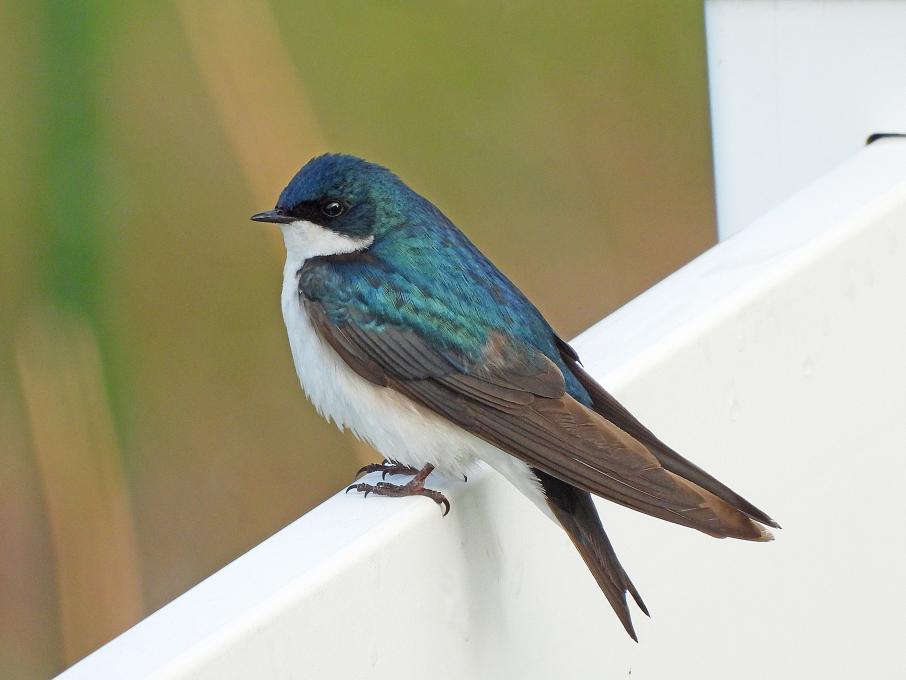

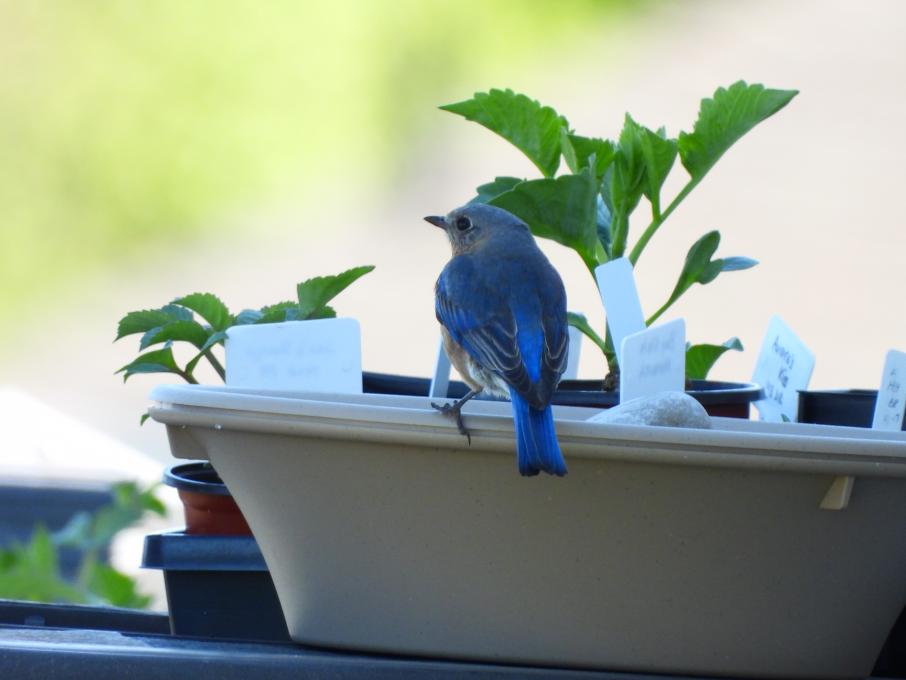
 Tanagers were in the manmade pond/waterfall in my wooded yard. I also see many woodpeckers, cardinals, nuthatches, and starlings regularly. At the lake about a quarter of a mile down, there are blue herons, swans, mallards, geese and kingfishers. Occasionally eagles are present as well.
Tanagers were in the manmade pond/waterfall in my wooded yard. I also see many woodpeckers, cardinals, nuthatches, and starlings regularly. At the lake about a quarter of a mile down, there are blue herons, swans, mallards, geese and kingfishers. Occasionally eagles are present as well. 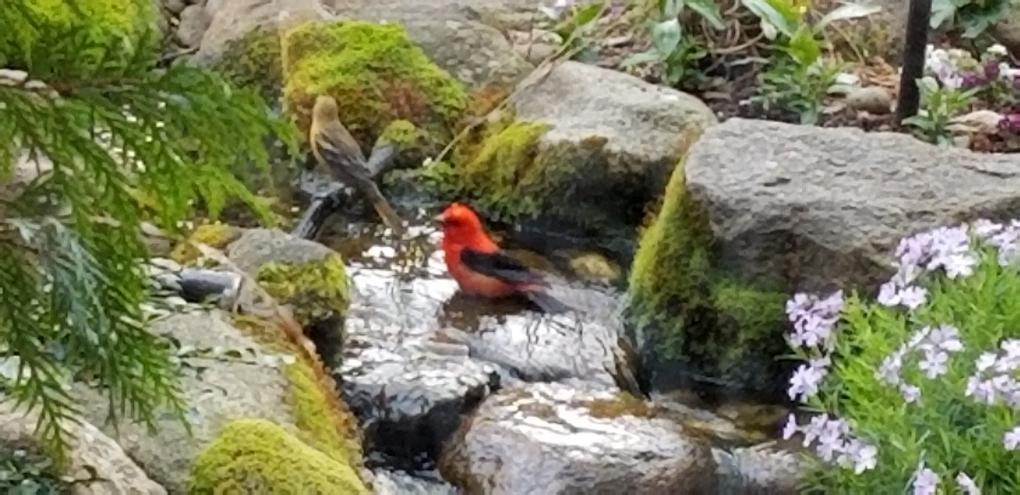
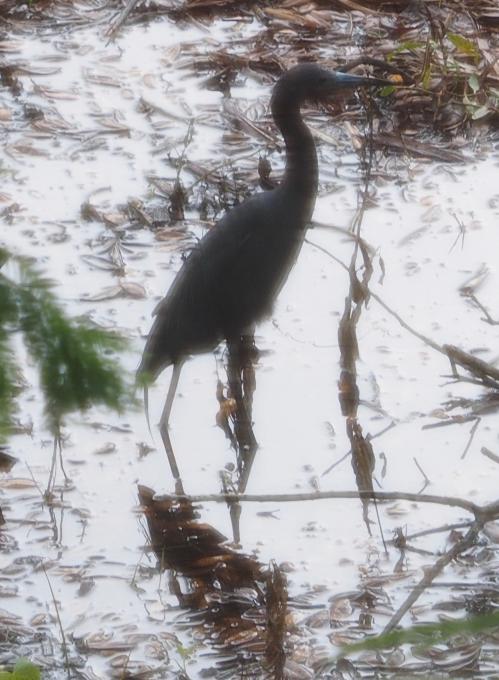 When I went over to the pond I saw redwing blackbirds and two interesting waterside sites.
When I went over to the pond I saw redwing blackbirds and two interesting waterside sites. One was a reddish egret (new bird for me this week) seen above with an Ibis. Below was where 2 of the ibis that are usually there went. Lok in the tree to their right and there was also a great blue heron in a place one might expect a raptor. He was about 40 feet above the mangrove and most smaller pines. I had seen the ibis but missed the great blue with out the aid of my 300mm of telephoto.
One was a reddish egret (new bird for me this week) seen above with an Ibis. Below was where 2 of the ibis that are usually there went. Lok in the tree to their right and there was also a great blue heron in a place one might expect a raptor. He was about 40 feet above the mangrove and most smaller pines. I had seen the ibis but missed the great blue with out the aid of my 300mm of telephoto.
 I went to familiar places and saw unfamiliar sights. Fun with birding..
I went to familiar places and saw unfamiliar sights. Fun with birding.. 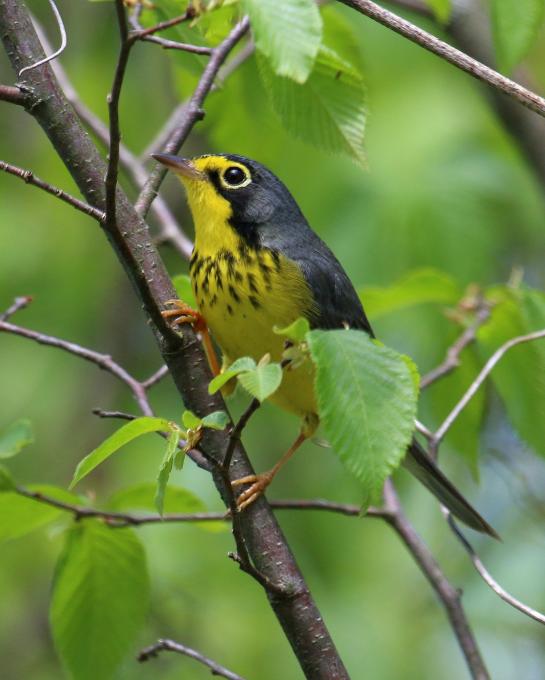

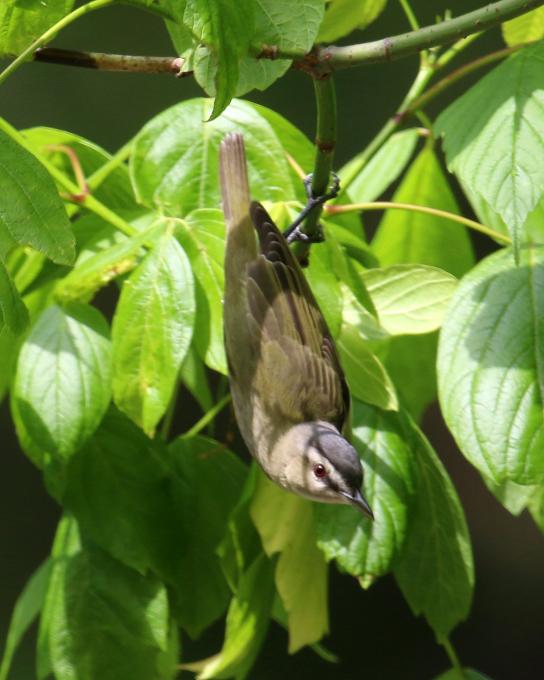
 We visited two local wooded trails (well known to us but now seen in a new light) with descriptions from our area Audubon birding map. The first site has a pond that attracts mallards, Wood Ducks, and (rarely) Green Herons. We didn't spot any ducks here although we had recently seen them at a National Wildlife Refuge Center (photo of mallard enclosed). One bonus of this hilly trail walk was noting we'd have a great high perch along this trail for viewing hawk migration in the fall. The second site visited was a trail alongside a creek that hosts large conifers and a shrubby understory used as habitat for migrant and wintering birds. We keep our Birding map in the car now---along with our binoculars!
We visited two local wooded trails (well known to us but now seen in a new light) with descriptions from our area Audubon birding map. The first site has a pond that attracts mallards, Wood Ducks, and (rarely) Green Herons. We didn't spot any ducks here although we had recently seen them at a National Wildlife Refuge Center (photo of mallard enclosed). One bonus of this hilly trail walk was noting we'd have a great high perch along this trail for viewing hawk migration in the fall. The second site visited was a trail alongside a creek that hosts large conifers and a shrubby understory used as habitat for migrant and wintering birds. We keep our Birding map in the car now---along with our binoculars! 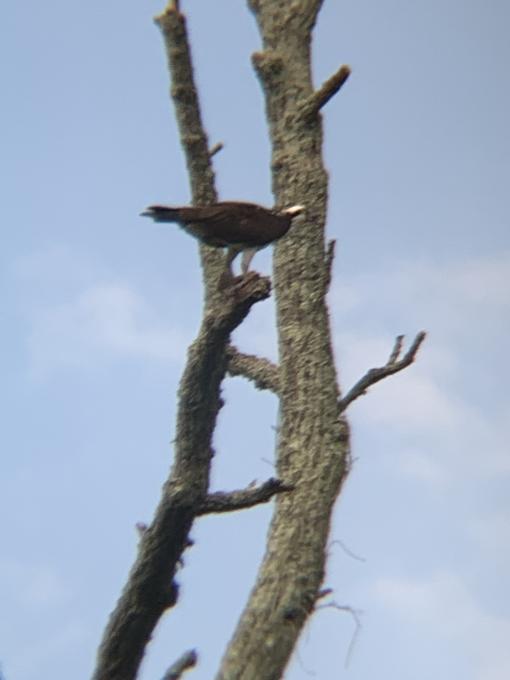

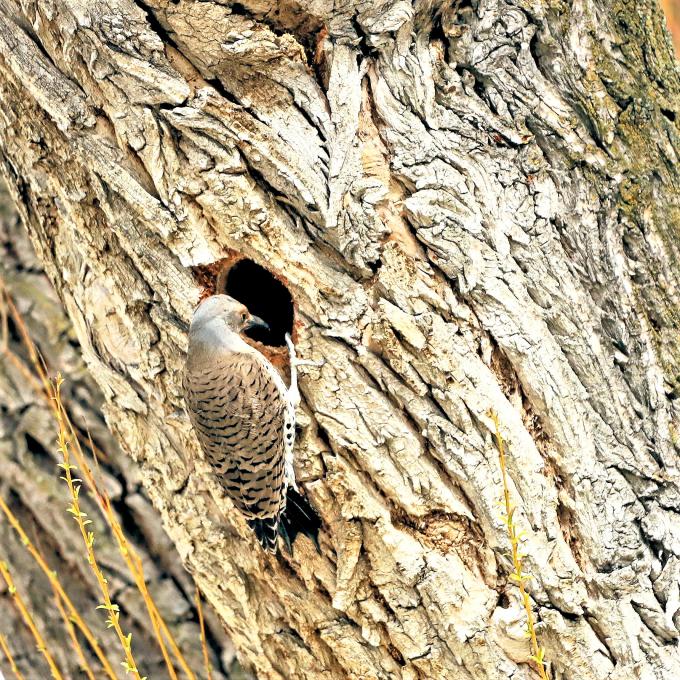



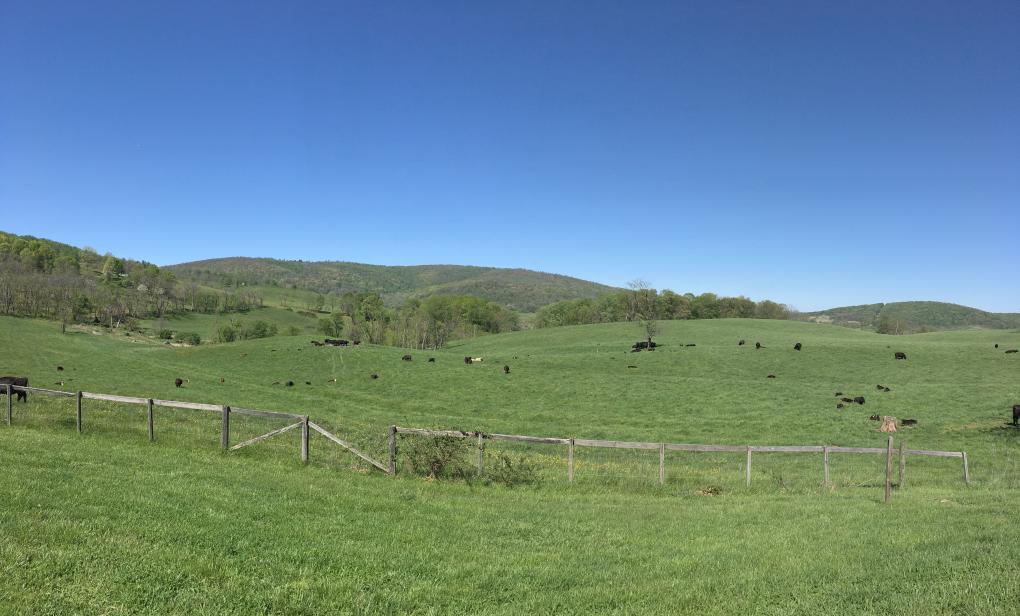 Open habitats: I drove to a parking area along a road adjacent to cow pastures. Along the fence line, I spotted a number of Tree Swallows (https://www.allaboutbirds.org/guide/Tree_Swallow/) going in and out of nest boxes there and also zipping and darting through the air above the field. Leaving the parking area on foot, I saw a Barn Swallow (https://www.allaboutbirds.org/guide/Barn_Swallow/), who, I kid you not, flew out of a barn! It was possible to further distinguish him by his deeply forked tail and orange-brown underside. Soaring above the fields were a few Turkey Vultures (https://www.allaboutbirds.org/guide/Turkey_Vulture/), judging by the gray flight feathers. They were riding thermals and looking for, presumably, dead stuff.
Open habitats: I drove to a parking area along a road adjacent to cow pastures. Along the fence line, I spotted a number of Tree Swallows (https://www.allaboutbirds.org/guide/Tree_Swallow/) going in and out of nest boxes there and also zipping and darting through the air above the field. Leaving the parking area on foot, I saw a Barn Swallow (https://www.allaboutbirds.org/guide/Barn_Swallow/), who, I kid you not, flew out of a barn! It was possible to further distinguish him by his deeply forked tail and orange-brown underside. Soaring above the fields were a few Turkey Vultures (https://www.allaboutbirds.org/guide/Turkey_Vulture/), judging by the gray flight feathers. They were riding thermals and looking for, presumably, dead stuff.
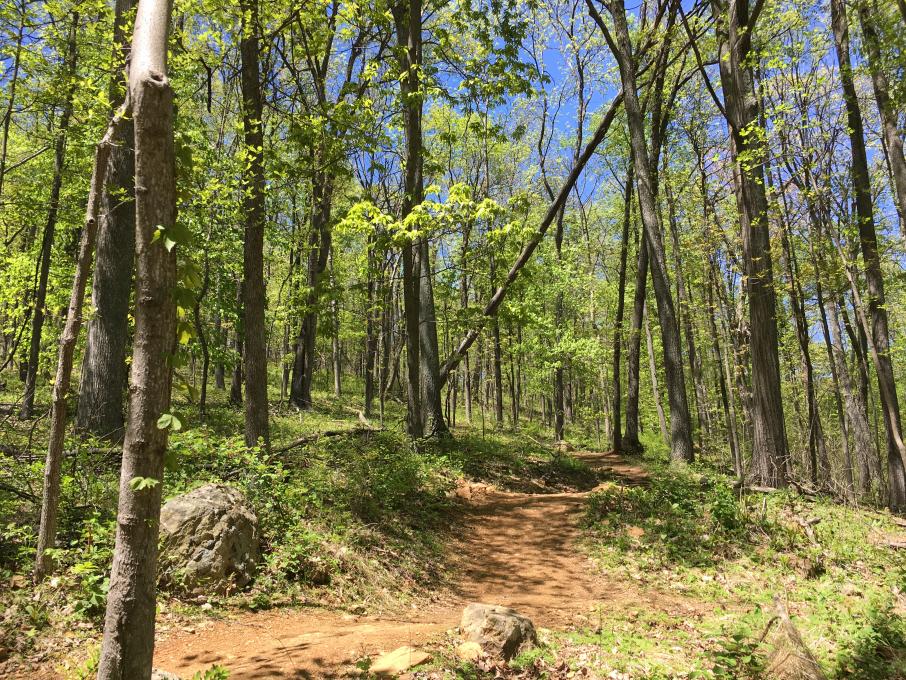 Forested habitats: Following the trail led me first into a mature forest. I could hear a number of different songs and calls but, this being decidedly not my backyard, the sounds were unfamiliar to me. I found it frustrating to be very close to birds but not able to see any… until a brilliant red caught my eye, high in the canopy: Scarlet Tanager (https://www.allaboutbirds.org/guide/Scarlet_Tanager/) hunting (?) along a branch. Merlin helped me to quickly identify this bird and listening to the in-app sound clips made me realize that I’d been hearing him all along! In the more open, second-growth part of the forest, I saw a pair of familiar American Goldfinches (https://www.allaboutbirds.org/guide/American_Goldfinch/) and a few less familiar Blue-gray Gnatcatchers (https://www.allaboutbirds.org/guide/Blue-gray_Gnatcatcher/) — the latter identified by their long, mostly black tails with white edges (helpful, since they were flitting about quickly overhead and hardly paused!). Finally, there was a bird that I wasn't able to see clearly enough to identify (I only have a pair of 8x21s after all): it was sparrow-sized and appeared to be feeding from a bloom high in the treetops. I guess it's good to always have at least one mystery to ponder.
Forested habitats: Following the trail led me first into a mature forest. I could hear a number of different songs and calls but, this being decidedly not my backyard, the sounds were unfamiliar to me. I found it frustrating to be very close to birds but not able to see any… until a brilliant red caught my eye, high in the canopy: Scarlet Tanager (https://www.allaboutbirds.org/guide/Scarlet_Tanager/) hunting (?) along a branch. Merlin helped me to quickly identify this bird and listening to the in-app sound clips made me realize that I’d been hearing him all along! In the more open, second-growth part of the forest, I saw a pair of familiar American Goldfinches (https://www.allaboutbirds.org/guide/American_Goldfinch/) and a few less familiar Blue-gray Gnatcatchers (https://www.allaboutbirds.org/guide/Blue-gray_Gnatcatcher/) — the latter identified by their long, mostly black tails with white edges (helpful, since they were flitting about quickly overhead and hardly paused!). Finally, there was a bird that I wasn't able to see clearly enough to identify (I only have a pair of 8x21s after all): it was sparrow-sized and appeared to be feeding from a bloom high in the treetops. I guess it's good to always have at least one mystery to ponder.